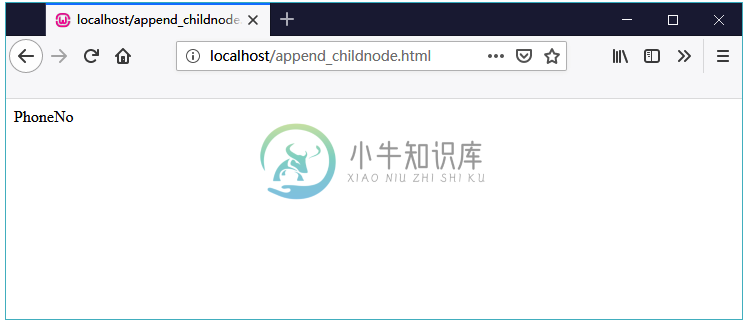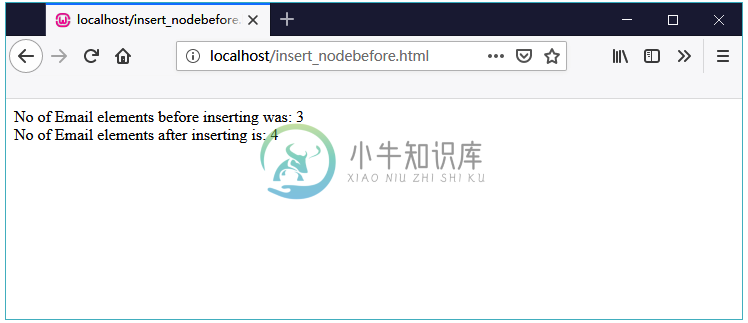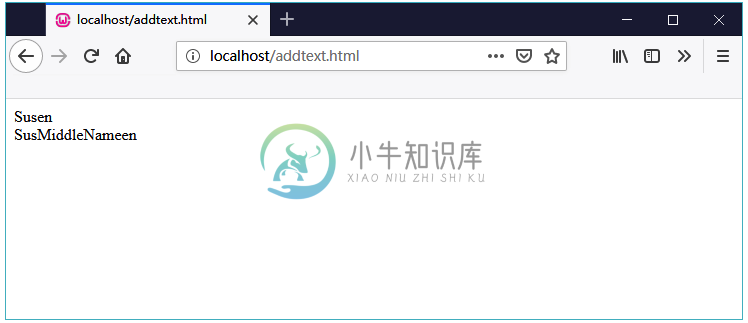XML DOM增加节点
精华
小牛编辑
109浏览
2023-03-14
在本章中,我们将讨论已存在元素的节点。在这节中将学习添加(或插入)新节点 -
- 在现有子节点之前或之后追加新的子节点
- 在文本节点中插入数据
- 添加属性节点
以下方法可用于将节点元素添加/附加到DOM中 -
appendChild()insertBefore()insertData()
1. 使用appendChild()方法
方法appendChild()用于向现有子节点之后添加新的子节点。
语法
appendChild()方法的语法如下 -
Node appendChild(Node newChild) throws DOMException
其中,
newChild− 要添加的新节点。- 此方法返回已添加的节点(
Node)。
示例
以下示例(append_childnode.html)将XML文档(node.xml)解析为XML DOM对象,并将新的子元素PhoneNo附加到元素 - <FirstName> 。
<!DOCTYPE html>
<html>
<head>
<script>
function loadXMLDoc(filename) {
if (window.XMLHttpRequest) {
xhttp = new XMLHttpRequest();
} else{ // code for IE5 and IE6
xhttp = new ActiveXObject("Microsoft.XMLHTTP");
}
xhttp.open("GET",filename,false);
xhttp.send();
return xhttp.responseXML;
}
</script>
</head>
<body>
<script>
xmlDoc = loadXMLDoc("/node.xml");
create_e = xmlDoc.createElement("PhoneNo");
x = xmlDoc.getElementsByTagName("FirstName")[0];
x.appendChild(create_e);
document.write(x.getElementsByTagName("PhoneNo")[0].nodeName);
</script>
</body>
</html>
在上面的例子中 -
- 使用
createElement()方法,创建一个新元素PhoneNo。 - 使用
appendChild()方法将新元素PhoneNo添加到元素FirstName中。
执行
运行上面示例代码,得到以下结果 -

2. insertBefore()方法
insertBefore()方法在指定的子节点之前插入新的子节点。
语法insertBefore()方法的语法如下 -
Node insertBefore(Node newChild, Node refChild) throws DOMException
其中,
newChild- 要插入的节点refChild- 是引用节点,即必须在其之前插入新节点的节点。- 此方法返回要插入的节点。
示例
以下示例(insert_nodebefore.html)将XML文档(node.xml)解析为XML DOM对象,并在指定元素<Email>之前插入新的子元素:Email。
<!DOCTYPE html>
<html>
<head>
<script>
function loadXMLDoc(filename) {
if (window.XMLHttpRequest) {
xhttp = new XMLHttpRequest();
} else{ // code for IE5 and IE6
xhttp = new ActiveXObject("Microsoft.XMLHTTP");
}
xhttp.open("GET",filename,false);
xhttp.send();
return xhttp.responseXML;
}
</script>
</head>
<body>
<script>
xmlDoc = loadXMLDoc("/node.xml");
create_e = xmlDoc.createElement("Email");
x = xmlDoc.documentElement;
y = xmlDoc.getElementsByTagName("Email");
document.write("No of Email elements before inserting was: " + y.length);
document.write("<br>");
x.insertBefore(create_e,y[3]);
y=xmlDoc.getElementsByTagName("Email");
document.write("No of Email elements after inserting is: " + y.length);
</script>
</body>
</html>
在上面的例子中 -
- 使用
createElement()方法,创建一个新元素Email。 - 使用
insertBefore()方法在元素Email之前添加新元素Email。 y.length给出新元素之前和之后添加的元素总数。
执行上面示例代码,得到以下结果 -

3. insertData()方法
insertData()方法在指定的16位单位偏移处插入一个字符串。
语法insertData()的语法如下 -
void insertData(int offset, java.lang.String arg) throws DOMException
其中,
offset- 是要插入的字符偏移量。arg- 是插入数据的关键词。它用括号括起两个参数:offset和arg,用逗号分隔。
示例
以下示例(addtext.html)将XML文档(node.xml)解析为XML DOM对象,并将指定位置的新数据MiddleName插入到元素<FirstName>。
<!DOCTYPE html>
<html>
<head>
<script>
function loadXMLDoc(filename) {
if (window.XMLHttpRequest) {
xhttp = new XMLHttpRequest();
} else{ // code for IE5 and IE6
xhttp = new ActiveXObject("Microsoft.XMLHTTP");
}
xhttp.open("GET",filename,false);
xhttp.send();
return xhttp.responseXML;
}
</script>
</head>
<body>
<script>
xmlDoc = loadXMLDoc("/node.xml");
x = xmlDoc.getElementsByTagName("FirstName")[0].childNodes[0];
document.write(x.nodeValue);
x.insertData(3,"MiddleName");
document.write("<br>");
document.write(x.nodeValue);
</script>
</body>
</html>
x.insertData(6,"MiddleName");− 这里,x保存指定子名称的名称,即<FirstName>。 然后,从位置3开始向该文本节点插入数据 -MiddleName。
执行上面示例代码,得到以下结果 -

